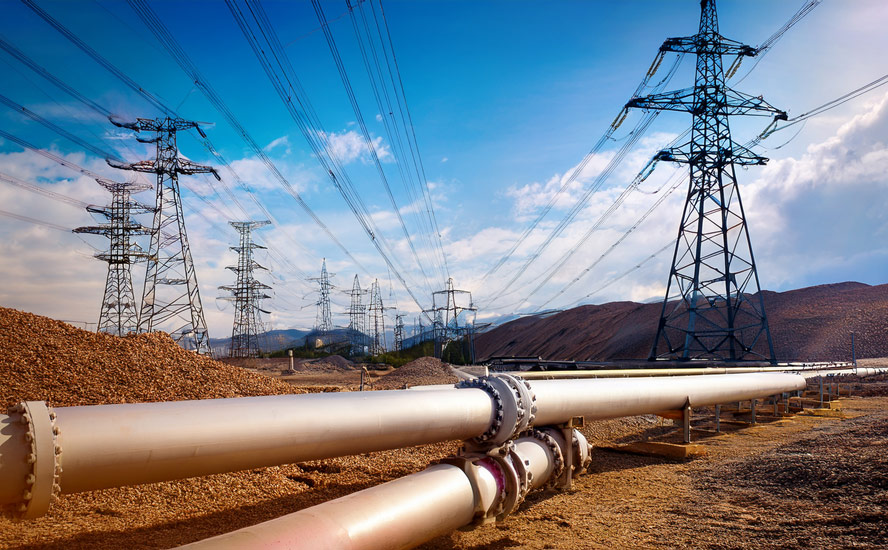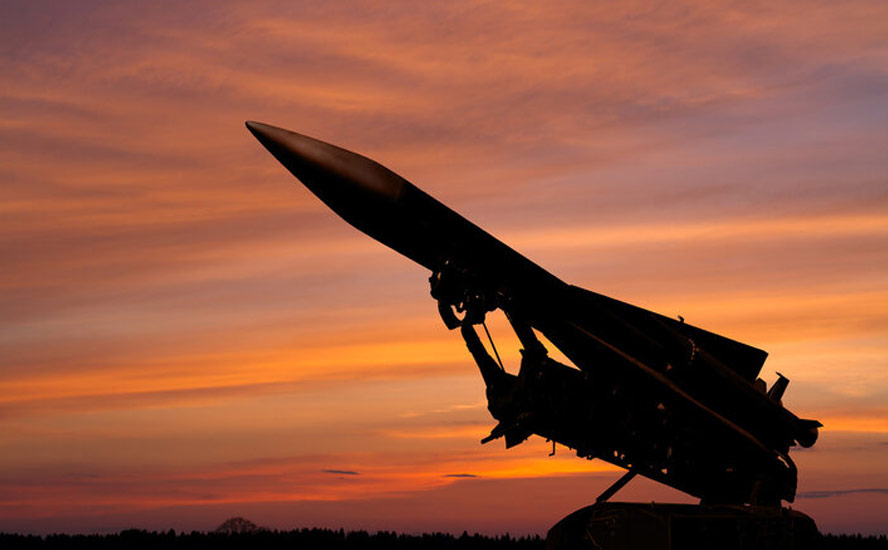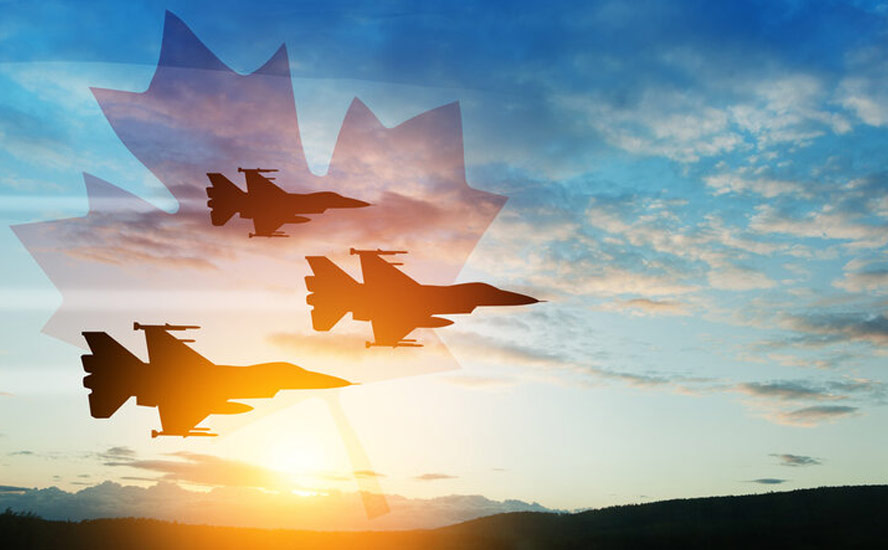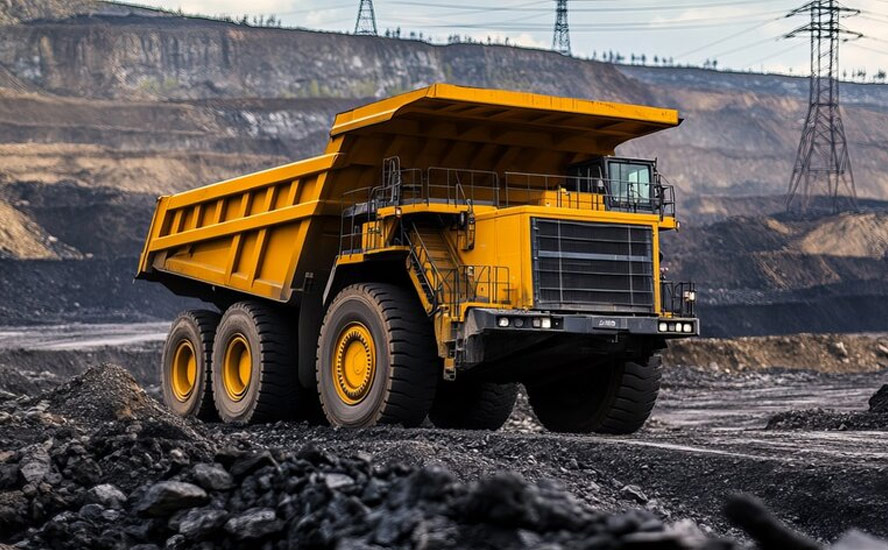What would a nuclear winter look like? – Richard Mills
2024.01.26
From 1950 to 1990, the biggest threat to the planet was not global warming, but nuclear war.
The Soviet Union’s launch of Sputnik, the first satellite, spurred the United States to develop rockets that could carry objects into space, which culminated in NASA’s moon landing of 1969.
The competition between the US and the USSR over space exploration morphed into the Cold War, as the two superpowers began developing nuclear weapons, first (and only ever) used at the end of the Second World War with the bombing of Hiroshima and Nagasaki.

Source: US Air Force Photo Library
The world’s first nuclear explosion occurred on July 16, 1945, when a test code-named Trinity set off a plutonium detonation device at Los Alamos, New Mexico. The event is the basis for the plot of the recent movie ‘Oppenheimer’, about American physicist Robert Oppenheimer, who headed the Manhattan Project during WW II.
(The blast was much stronger than anticipated — the irradiated mushroom cloud went 50,000-70,000 feet into the atmosphere. Recent research reveals that radioactive fallout reached 46 states, Canada and Mexico within 10 days.)

On August 29, 1949, the Soviet Union detonated its first nuclear device at a remote site in Kazakhstan.
The phrases “nuclear deterrence” and “mutually assured destruction” entered the lexicon, as both sides envisioned having so many “nukes” — both land and sea-based — that to deploy even one would result in a retaliatory strike that could bring about nuclear war.
For civilians, the constant threat of nuclear annihilation was reinforced through public education programs like “duck and cover”, which taught students in the 1950s how to dive under their desks and cover their heads in the event of a nuclear attack; and the documentary ‘If You Love This Planet’, released in 1982 to educate/ scare Canadians about the horrors of nuclear war and the arms race.
The threat and consequences of nuclear war have manifested in various ways throughout popular culture. Nuclear weapons have been a central theme of movies since ‘The Day the Earth Stood Still’ in 1951. Probably the most famous was Stanley Kubrick’s 1964 masterpiece, ‘Dr. Strangelove’. More recent examples include ‘The Day After’, ‘Crimson Tide’, ‘The Sum of All Fears’ and ‘The Fourth Protocol’.
Dystopian novels such as ‘Alas’, ‘Babylon’ and ‘On The Beach’ portray the grim aftermath of nuclear war.
Musicians warned of nuclear destruction in 1980s rock music such as ’99 Luftballoons’ by Nena, ‘Seconds’ by U2, ‘Atomic’ by Blondie, ‘2 Minutes to Midnight’ by Iron Maiden and ‘Blackened’ by Metallica.
The dissolution of the Soviet Union in 1989 officially ended the Cold War, but has not resulted in the elimination of nuclear weapons. Despite several nuclear disarmament treaties (for a list consult this Wikipedia page), world peace is still very much threatened by the outbreak of nuclear war.
Who’s armed?
According to the International Campaign to Abolish Nuclear Weapons (ICAN), there are currently nine countries that possess atomic weapons: Russia, the United States, China, France, United Kingdom, India, Pakistan, Israel and North Korea. Between these states, they have 12,700 nuclear warheads, of which 9,400 are in military stockpiles. While this is down significantly from the 70,000 warheads owned by nuclear-armed states during the Cold War, “nuclear arsenals are expected to grow over the coming decade and today’s forces are vastly more capable,” states ICAN.
There are also five countries that “host” US nuclear weapons — Belgium, Germany, Italy, the Netherlands and Turkey — and 29 that “endorse” the possession and use of nuclear weapons by allowing the potential use of nukes on their behalf as part of defense alliances including the North Atlantic Treaty Organization (NATO). These 29 countries include Australia, Canada, Denmark, Finland, Sweden, Greece, Poland, Portugal, Spain, Japan, and South Korea.



Potential scenarios
Today there are numerous global flash points that, if escalated, could result in the release of a nuclear weapon that kills and maims tens, possibly hundreds of thousands of people, causes radiation sickness, cancer, and wreaks environmental devastation the likes of which we haven’t seen since the atomic bombing of Japan in 1945.
One has only to glance at last week’s headlines to see that nuclear-armed Pakistan has just attacked Iran, which thankfully does not yet have the bomb but is trying hard to acquire the materials to build one.
According to Reuters, Iran launched missiles strikes on Iraq, Syria and Pakistan — all of which were responses to attacks carried out on its soil or against Iranian targets.
In Pakistan, Iranian state media said Iran destroyed two bases of Baluchi militant Jaish al Adl, a Pakistan-based group that claimed a December attack which killed Iranian security forces. Pakistan launched strikes on separatist militants inside Iran on Thursday in response.
The news outlet says the greatest risk of escalation lies in a miscalculated attack carried out by Iran or its proxies on one side, such as the killing of US troops, or America and its allies on the other.
There is also the possibility of Russia getting involved, given that Iran and Russia have grown closer recently, united in their isolation under US sanctions and their opposition to US global hegemony. Iran provides Moscow with drones for its assault on Ukrainian cities, and both countries intervened in Syria to support their mutual ally President Assad, Reuters noted.
Speaking of Russia, back in August, former Russian prime minister Dmitry Medvedev threatened to use nuclear weapons if Ukraine’s counter-offensive threatens Russian territory. On Sunday, a large-scale attack on a market in the Russian-occupied city of Donetsk left 27 people dead and 26 injured. Russia blamed Ukraine for the carnage but a regional Ukrainian army group denied it, according to CNBC.
One could easily envision a scenario whereby Russia, penned in by NATO countries and facing advances by Urkrainian troops on its territory and/or attacks by weaponry provided by the West, retaliates by firing off a short-range nuclear weapon. This could then spiral into the use of longer-range missiles carrying nuclear warheads directed at Ukrainian cities or even European countries Ukraine has allied with.
Russia has the most nuclear warheads of any nation, 5,997, narrowly edging out the United States’ 5,428.
But remember, India and Pakistan are nuclear-armed, so is Israel and, most frighteningly, North Korea.
Last year, a US intelligence report raised concerns over the possibility of India retaliating against Pakistan in the event of a terror attack, or if there is “violent unrest in Kashmir” orchestrated by extremist groups based in Pakistan. (Mint, March 9, 2023)
January 23 was Israel’s deadliest day since the Gaza war began, after two buildings collapsed on Israeli soldiers. Wall Street Journal reported 21 of 24 soldiers were killed when two structures they were rigging for demolition caved in, after militants fired rocket-propelled grenades at one of the buildings.
In November, Israeli Heritage Minister Amihai Eliyahu said a nuclear bomb on the Gaza Strip was “an option”, a statement condemned by China, Iran and several Arab nations, and for which Eliyahu was later suspended from Cabinet meetings.
While not specifically a nuclear threat, the fact that the Iran-backed Houthis in Yemen have been flinging missiles at ships in the Red Sea and at southern Israel, should raise alarm bells. Forbes said the Aqeel guided missile has an approximate range of 620 miles (1,000 km), the Houthis have a mid-range variant of Iran’s Zolfaghar ballistic missile, also capable of traveling 620 miles, and a longer-range Toufan (Typhoon), able to strike targets 840-1,180 miles away, has been linked with Iran’s Ghadr ballistic missiles. This is a degree of military sophistication far greater than the shoulder-fired RPGs used by the Taliban or the improvised explosive devices (IEDs) planted by ISIS.
Does anyone really believe that Iran, if it gets the bomb, or its proxies Hezbollah, Hamas or the Houthis, would hesitate to use it?
Finally, the ever-present possibility of a nuclear attack by North Korea is again making the news. Earlier this month, the North tested what it says is a solid-fueled hypersonic missile and an underwater nuclear drone, in response to a large joint naval exercise by the US, South Korea and Japan.
Leader Kim Jong Un has reportedly given up on the idea of peaceful reunification with the South, designating it a hostile state and warning of possible war.
On New Year’s Day, ICAN said South Korea’s defense ministry repeated previous threats to destroy the North Korean regime if it uses nuclear weapons.
Analysts believe Pyongyang is developing both so-called strategic and tactical nuclear weapons in order to deter the US which is committed to use nuclear weapons in South Korea’s defence.
North Korea has been testing more and more advanced ballistic missiles and warheads, some with the range to reach the US and has also said it is developing ship-launched cruise missiles, while the Americans have been mounting repeated shows of force including military exercises using nuclear-capable aircraft and the visit of a nuclear-armed submarine to South Korea.

Source: Korean Central News Agency
Nuclear winter
While the above-mentioned ‘Oppenheimer’ has renewed interest in the history of the atomic bomb, one thing you won’t learn about from the film starring Cillian Murphy (‘Peaky Blinders’) are the potential effects of a nuclear winter.
The term was first brought to the world’s attention by Carl Sagan, the astrophysicist and author, in 1983.
Wikipedia defines nuclear winter as a severe and prolonged global climatic cooling effect that is hypothesized to occur after widespread firestorms following a large-scale nuclear war. The hypothesis is based on the fact that such fires can inject soot into the stratosphere, where it can block some direct sunlight from reaching the surface of the Earth. It is speculated that the resulting cooling would lead to widespread crop failure and famine.
Encyclopedia Britannica goes further into detail on the causes of nuclear winter, stating that,
The basic cause of nuclear winter, as hypothesized by researchers, would be the numerous and immense fireballs caused by exploding nuclear warheads. These fireballs would ignite huge uncontrolled fires (firestorms) over any and all cities and forests that were within range of them. Great plumes of smoke, soot, and dust would be sent aloft from these fires, lifted by their own heating to high altitudes where they could drift for weeks before dropping back or being washed out of the atmosphere onto the ground. Several hundred million tons of this smoke and soot would be shepherded by strong west-to-east winds until they would form a uniform belt of particles encircling the Northern Hemisphere from 30° to 60° latitude. These thick black clouds could block out all but a fraction of the Sun’s light for a period as long as several weeks. Surface temperatures would plunge for a few weeks as a consequence, perhaps by as much as 11° to 22° C (20° to 40° F). The conditions of semidarkness, killing frosts, and subfreezing temperatures, combined with high doses of radiation from nuclear fallout, would interrupt plant photosynthesis and could thus destroy much of the Earth’s vegetation and animal life. The extreme cold, high radiation levels, and the widespread destruction of industrial, medical, and transportation infrastructures along with food supplies and crops would trigger a massive death toll from starvation, exposure, and disease. A nuclear war could thus reduce the Earth’s human population to a fraction of its previous numbers.
Using computer models, researchers found that the ignition of 100 firestorms, each comparable in intensity to the Hiroshima blast, could produce a “small” nuclear winter that would cool the global climate by approximately 1 degree Celsius, canceling out the effects of global warming for two to three years. The injection of 5 teragrams (Tg) of soot into the stratosphere would lead to mass food shortages. According to one model, livestock and aquatic food production could not compensate for reduced crop output in almost all countries.
In the event of an American-Soviet war, climate modelers in the 1980s speculated that a much larger number of firestorms, in the thousands, would plunge the Earth into a nuclear winter lasting up to a decade. During this period, summers could be 20 degrees cooler in agricultural regions of the US, Europe and China, and 35 degrees colder in Russia. Cooling would be produced due to a 99% reduction in the amount of solar radiation reaching the planet’s surface.
Other studies focused on the layer of ozone in the stratosphere that shields living things from the sun’s harmful ultraviolet rays. Nuclear explosions containing large amounts of nitrogen oxides could potentially deplete the ozone layer.
Rutgers University paper
A 2010 research paper by Rutgers University contains the following nuggets of information, lightly edited:
- Smoke from the fires started by nuclear weapons, especially the black, sooty smoke from cities and industrial facilities, would be heated by the Sun, lofted into the upper stratosphere, and spread globally, lasting for years. The resulting cool, dark, dry conditions at Earth’s surface would prevent crop growth for at least one growing season, resulting in mass starvation over most of the world. In addition, there would be massive ozone depletion, allowing enhanced ultraviolet radiation. More people could die in the noncombatant countries than in those where the bombs were dropped, because of these indirect effects.
- A nuclear war between India and Pakistan could produce so much smoke that it would produce global environmental change unprecedented in recorded human history. Although the number of nuclear weapons in the world has fallen from 70,000 at its peak in the 1980s to less than 10,000 currently deployed, a nuclear war between the United States and Russia could still produce nuclear winter.
- On August 6, 1945, a 15-kt nuclear bomb was dropped on Hiroshima, Japan, killing approximately 150,000 people. The total explosive power of the current arsenal becomes more meaningful when considered in perspective. There is the equivalent explosive power of more than 1 ton of TNT for each human on the face of the Earth. The 15-kt Hiroshima bomb was only 0.00018% of the current global arsenal.
- The total explosive power of all bombs dropped in all of World War II, during which 50,000,000 people died, including Hiroshima and Nagasaki, was 3 Mt. The total explosive power of all bombs ever used in the history of the world in wars is 10 Mt, with 4 Mt of those dropped in the Vietnam war. Yet we now have 850 times that explosive power in the world arsenals.
- About one-third of the energy of a nuclear explosion is in the form of light or heat. Like a giant match, it causes cities and industrial areas to burn. Following the flash of light comes the blast wave (like thunder following lightning) which will break apart many structures and blow out the flames, but crumpled structures burn more easily and fires would be reignited by burning embers and electrical sparks. Imagine how easily a house would burn with open gas lines or a filling station with gas pumps knocked over. In fact, there are many flammable sources of fuel for fires in cities, including buildings and their contents, trees, and even asphalt. Modern materials, such as plastics, not only burn with a sooty smoke, but also produce high levels of toxic chemicals.
- The direct effects of the nuclear weapons, blast, radioactivity, fires, and extensive pollution would kill millions of people, but only those near the targets. However, the fires would have another effect. Massive amounts of dark smoke from the fires would be lofted into the upper troposphere, 10–15 km above Earth’s surface in the tropics and 6–8 km above the surface in higher latitudes, and then absorption of sunlight would further heat the smoke, lifting it into the stratosphere, a layer where the smoke would persist for years, with no rain to wash it out.
Effects on agriculture/ biological consequences
- The most important consequence of nuclear winter for humans is the disruption of food supplies. This comes from environmental disruptions that reduce or completely wipe out agricultural production and the disruption of the distribution mechanisms.
- Not only would it be virtually impossible to grow food for 4–5 years after a 150-Mt nuclear holocaust, but it would also be impossible to obtain food from other countries.
- Only one day with the temperatures below freezing is enough to kill rice crops. Colder temperatures mean shorter growing seasons, and also slower maturation of crops; the combination results in much lower yields. Most of the grains that are grown in midlatitudes, such as corn, are actually of tropical origin, and will only grow in summer-like conditions. For example, a study done in Canada shows that with summer temperatures only 3◦C below normal, spring wheat production would halt. Insufficient precipitation would also make agriculture difficult.
- Farmers depend on fuel for their machinery, fertilizer, and pesticides, none of which would be available or distributed in the aftermath of a war. Furthermore, insects have a higher tolerance for radiation and the stresses that would follow than do their predators, such as birds. Whatever might grow would be eaten by pests, already a significant problem in today’s production. Also, the seeds that are in use were designed to yield high productivity assuming the current climate and inputs of chemicals and energy as discussed above. These seeds would not grow well in a radically altered growing environment.
- Most of the world’s people are threatened with starvation following a full-scale nuclear war. Each person who will survive becomes a vegetarian and eats the minimum needed for survival. In many nations, people would be reduced to a hunter/gatherer existence with nothing to hunt and precious little to gather.
- The effects on health would add to the misery. Immune deficiencies can be produced by any of the following: burns and trauma, radioactivity, malnutrition, psychological stress, and UV-B radiation. All of these would be present for the survivors in the target nations. Pollution from dioxins, PCBs, asbestos, and other chemicals will make the air unhealthy to breath.
- Although the ocean would not cool very fast, the darkness would decimate the phytoplankton, which are at the base of the oceanic food chain. That, combined with toxic and radioactive pollution, would severely limit the food sources in the oceans.
Shades of winter
The 2010 Rutgers University paper, and later research by the Alliance for Science, detail a few different scenarios that could plunge the Earth into a nuclear winter of varying degrees.
If 50 nuclear weapons were dropped on two countries, they could produce 5 Tg of black smoke, after accounting for the amount emitted by the fires and immediately washed out in rain.
A war between the US and Russia could produce 150 Tg of smoke.
Rutgers says the climatic effects of smoke from burning cities and industrial areas would last for several years, much longer than previously thought. A nuclear war between India and Pakistan, with each country using 50 Hiroshima-sized bombs as airbursts on urban areas, could produce climate change unprecedented in recorded human history — and that’s with less than 0.02% of the explosive power of the current nuclear arsenal. The same scenario would produce global ozone depletion.
The injection of just 5 Tg of smoke into the upper troposphere would cause global temperatures to plummet to values below those of the Little Ice Age (1500-1850). I.e., during the Little Ice Age, global temperatures were half a degree Celsius cooler, but in a nuclear winter scenario they would fall by about 1.25 degrees, last for several years, and after 10 years would still be 0.5 degrees colder than normal.
Global precipitation would be reduced by 10%.
Rutgers says while these temperatures would not be winter-like, growing seasons in midlatitudes of both hemispheres would be shortened by up to a few weeks, with potentially large impacts on agricultural production.
A nuclear war between the United States and Russia could produce 150 Tg of smoke and nuclear winter, with temperatures plunging below freezing in the summer in major agricultural regions, threatening the food supply for most of the planet, the researchers say.
In 2022, the Alliance for Science asked the question: Could humans survive a nuclear war between NATO and Russia? The short answer is yes, But the vast majority of the human population would suffer extremely unpleasant deaths from burns, radiation and starvation, and human civilization would likely collapse entirely. Survivors would eke out a living on a devastated, barren planet.
The Alliance quotes a study published three years ago looking at the likely impacts of a nuclear exchange of about 100 Hiroshima-sized detonations on the most populated areas of India and Pakistan. This scenario, the same as the one described by Rutgers, would generate about 5 Tg of soot-filled smoke, dropping the Earth’s surface temperature by 1.8 degrees in the first five years.
The Alliance notes this would cause more cooling than any recent volcanic eruption (see section below), and more than any climate perturbation for at least the last 1,000 years. Rainfall patterns would be greatly altered and total precipitation would fall about 8%.
Food exports would collapse as stocks are depleted within one year, and by the fourth year 1.3 billion people face losing about 20% of their current food supply.
A 2014 study using the same scenario found that the soot entering the stratosphere would severely damage the ozone layer, increasing UV penetration by 30-80% over the mid-latitudes. This would cause “widespread damage to human health, agriculture, and terrestrial and aquatic ecosystems,” the researchers wrote. “The combined cooling and enhanced UV would put significant pressures on global food supplies and could trigger a global nuclear famine.”
As for the US-Russia nuclear war scenario, the Alliance for Science quotes a 2008 study estimating it would cause 770 million direct deaths and generate 180 Tg of soot from burning cities and forests. About half the US population would be within ground zero and a fifth of the country’s citizens would be killed outright.
A subsequent study in 2019, which used a slightly lower 150 Tg soot injection, found that an equivalent-scale nuclear war would cause so much smoke that only 30-40% of sunlight would reach the Earth’s surface for six months. What happens next is worth quoting in full:
A massive drop in temperature follows, with the weather staying below freezing throughout the subsequent Northern Hemisphere summer. In Iowa, for example, the model shows temperatures staying below 0°C for 730 days straight. There is no growing season. This is a true nuclear winter.
Nor is it just a short blip. Temperatures still drop below freezing in summer for several years thereafter, and global precipitation falls by half by years three and four. It takes over a decade for anything like climatic normality to return to the planet.
By this time, most of Earth’s human population will be long dead. The world’s food production would crash by more than 90 percent, causing global famine that would kill billions by starvation. In most countries less than a quarter of the population survives by the end of year two in this scenario. Global fish stocks are decimated and the ozone layer collapses.
The models are eerily specific. In the 4,400 warhead/150 Tg soot nuclear war scenario, averaged over the subsequent five years, China sees a reduction in food calories of 97.2 percent, France by 97.5 percent, Russia by 99.7 percent, the UK by 99.5 percent and the US by 98.9 percent. In all these countries, virtually everyone who survived the initial blasts would subsequently starve.
Analogs
While the characteristics of a nuclear winter cannot obviously be replicated in the natural world, we do have analogs we can draw upon. For example, researchers use the conventional bombing of Hamburg, and the Hiroshima firestorm as examples of events that injected soot into the stratosphere. (As devastating as Hiroshima was, it was not enough to cause a nuclear winter).
Large wildfire firestorms can produce enough particulate matter to block out the sun, thus simulating nuclear winter conditions.
We can also examine the consequences of major volcanic eruptions, and the asteroid strike that hit Mexico’s Yucatan peninsula, causing the extinction of the dinosaurs.
Asteroid strike
Regarding the latter, Rutgers says the Cretaceous-Tertiary (K-T) extinction that happened about 65 million years ago caused a gargantuan dust cloud, that mixed with smoke from fires, blotted out the sun, killing the dinosaurs and starting the age of mammals. The K-T extinction may have been exacerbated by massive volcanism in India at the time, the researchers said.
(The Alliance for Science maintains that even the 150 Tg of soot released into the upper atmosphere in a full-scale nuclear war scenario is orders of magnitude less than the amount of smoke and particulate matter caused by the asteroid strike. This implies that a species-level extinction of Homo sapiens is unlikely, and that some humans would survive to eventually re-populate the planet.)
Volcanic eruptions
One of the best analogs for a nuclear war scenario is the eruption of Mount Tambora in Indonesia in 1815 — the largest of the past 500 years. An aerosol cloud of fine particulate matter the size of Australia reached the stratosphere, blocking sunlight from reaching the Earth, and cooling the planet by an average of 3 C. The climate effects lasted at least three years.
According to an article by the National Park Service, during what should have been the summer of 1816, Crops failed across Europe and the U.S. due to the cold or lack of sunshine causing grain and oat prices to soar, torrential rains flooded crops in Ireland, novel strains of cholera killed millions in India, crime became rampant, and people starved in many countries.
Other effects included crop-killing frosts every month of the summer in New England, plummeting livestock prices as farmers sold the animals they couldn’t feed, and the beginning of a mass migration westward from the US East Coast across the Appalachians to the Midwest.
Eruptions with similar effects occurred at Krakatoa, Indonesia, in 1813, and at Pinatubo, the Philippines, in 1991. Rutgers says that following the Pinatubo volcanic event, global precipitation, river flow, and soil moisture all were reduced, since cooling the planet by blocking sunlight has a strong effect on reducing evaporation and weakening the hydrologic cycle.

Forest fires
Less impactful but worth mentioning, are smoke from forest fires and cities burning. A 2006 study by Mike Fromm of the Naval Research Laboratory found that each natural occurrence of a massive wildfire firestorm, much larger than that observed at Hiroshima, can produce minor “nuclear winter” effects, with short-lived, approximately one month of a nearly immeasurable drop in surface temperatures, confined to the hemisphere that they burned in. This is somewhat analogous to the frequent volcanic eruptions that inject sulfates into the stratosphere and thereby produce minor, even negligible, volcanic winter effects. (Wikipedia)
Rutgers notes that smoke from large forest fires sometimes is injected into the lower stratosphere, and the smoke travels large distances, producing a cooling effect under the smoke.
Cities burning
There have been several examples of cities burning, whereby firestorms created by the intense release of energy pumped smoke into the upper atmosphere. These include San Francisco following the 1906 earthquake, and cities bombed during World War II, such as Tokyo, Dresden, Hamburg, Hiroshima and Nagasaki.
More recently, Iraqi troops set fire to about 700 oil wells in Kuwait, at the end of the 1991 Gulf War.
Conclusion
In 1962, we sat perched on the brink of nuclear war when the United States and the Soviet Union stared each other down over nuclear missiles placed on the island of Cuba.
For many people, this is ancient history and the idea of nuclear war is an anachronism — a relic of the 20th century that could never happen in the modern world.
The reality is we are closer than ever to a nuclear confrontation, evidenced by a number of global spots involving nuclear-armed states, most obviously Russia and Israel but also North Korea, which is back to rattling sabers with South Korea and testing nuclear weapons including a hypersonic missile and an underwater nuclear drone.
In fact there is a way of measuring the threat of nuclear war or other means of planetary destruction; it’s called the “Doomsday Clock”. Created in 1947 to warn humankind as to how close it is to destroying the world, the Doomsday Clock currently reads 90 seconds to midnight. It was set on Tuesday by The Bulletin of Atomic Scientists, to the same time as last year, the theoretical point of annihilation.
Reuters reported the atomic scientists set the clock based on “existential” risks to Earth: nuclear threats, climate change and disruptive technologies such as artificial intelligence and new biotechnology.
Regarding AI, scientific journal ‘The Bulletin’ called the technology “the most significant development” in the disruptive technology space, and mentions it increasingly being used by the military and information operations. Despite some countries taking steps to regulate artificial intelligence, the paper via Cointelegraph points out that AI and other information technologies have also been a cause for acceleration of the ability of authoritarian regimes to monitor citizens’ activities and liberties.
Via Reuters, The Bulletin of Atomic Scientists identified the following as factors driving the risk of global catastrophe:
- China, Russia and the United States are all expanding their nuclear arsenals, boosting the risk of nuclear war through mistake or miscalculation;
- Russia’s invasion of Ukraine has escalated tensions with the West to their most dangerous levels since the Cold War;
- Russian President Vladimir Putin in February 2023 suspended Russian participation in the New START treaty with the United States, that limits both countries’ strategic nuclear arsenals.
- There is also the March 2023 announcement of Russia’s deployment of tactical nuclear weapons in Belurus, and the Russian parliament’s October 2023 passage of a law withdrawing ratification of the global treaty banning nuclear weapons tests.
- Israel’s war with Hamas is another potential nuclear trigger. The Bulletin of Atomic Scientists worry the conflict could escalate (it already has — Rick), drawing in more nuclear or near-nuclear powers;
- Climate change was added as a factor in setting the clock in 2007. Last year was the hottest year on record.
As the Alliance for Science puts it, “we are no longer in peacetime and the shadows of multiple mushroom clouds are looming once again over our planet.”
It wouldn’t take much for one of the world’s nine nuclear-armed states to deploy a small nuclear weapon to end a conflict. The most obvious examples are Russia, Israel or North Korea, but the United States cannot be eliminated, not should it be discounted, as a nuclear threat. Always remember it was the US that invented the atomic bomb, tested it in the desert, and dropped it on two Japanese cities.
Also, the first casualty of war is truth. In the 2003 documentary ‘The Fog of War’, former Secretary of State Robert McNamara admitted that the supposed Aug. 4, 1964 attack on the USS Maddox in the Gulf of Tonkin — the precursor to US involvement in Vietnam — never happened. A similar mistake that involves launching a nuclear weapon in retaliation is a distinct possibility.
Researchers have modeled a “modest” nuclear exchange of about 100 Hiroshima-sized detonations on the most populated areas of India and Pakistan, would generate about 5 Tg of black smoke, dropping the Earth’s surface temperature by 1.8 degrees in the first five years.
Food exports would collapse as stocks are depleted within one year, and by the fourth year 1.3 billion people face losing about 20% of their current food supply.
Virtually every climate model has confirmed that nuclear war would cool the planet, with devastating effects on agriculture and many negative impacts on human mental and physical health.
As CBC notes, “A full-scale nuclear war and a global famine resulting from nuclear winter would lead to the collapse of industrial society and human civilization,” although those who have studied the topic believe that it wouldn’t necessarily extinguish the human species. The small number of people able to survive a nuclear winter could conceivably re-populate the planet.
Yet this shouldn’t be a reason to resist nuclear disarmament, or to not do whatever we can to avoid a nuclear incident. A 2022 paper in ‘Nature Food’ found that up to 5.3 billion people would die from starvation two years after a full-scale nuclear exchange between the US and Russia and the ensuing nuclear winter. The paper, via CBC, also found 99% of Canadians would starve to death.
Richard (Rick) Mills
aheadoftheherd.com
subscribe to my free newsletter
Legal Notice / Disclaimer
Ahead of the Herd newsletter, aheadoftheherd.com, hereafter known as AOTH.
Please read the entire Disclaimer carefully before you use this website or read the newsletter. If you do not agree to all the AOTH/Richard Mills Disclaimer, do not access/read this website/newsletter/article, or any of its pages. By reading/using this AOTH/Richard Mills website/newsletter/article, and whether you actually read this Disclaimer, you are deemed to have accepted it.
Any AOTH/Richard Mills document is not, and should not be, construed as an offer to sell or the solicitation of an offer to purchase or subscribe for any investment.
AOTH/Richard Mills has based this document on information obtained from sources he believes to be reliable, but which has not been independently verified.
AOTH/Richard Mills makes no guarantee, representation or warranty and accepts no responsibility or liability as to its accuracy or completeness.
Expressions of opinion are those of AOTH/Richard Mills only and are subject to change without notice.
AOTH/Richard Mills assumes no warranty, liability or guarantee for the current relevance, correctness or completeness of any information provided within this Report and will not be held liable for the consequence of reliance upon any opinion or statement contained herein or any omission.
Furthermore, AOTH/Richard Mills assumes no liability for any direct or indirect loss or damage for lost profit, which you may incur as a result of the use and existence of the information provided within this AOTH/Richard Mills Report.
You agree that by reading AOTH/Richard Mills articles, you are acting at your OWN RISK. In no event should AOTH/Richard Mills liable for any direct or indirect trading losses caused by any information contained in AOTH/Richard Mills articles. Information in AOTH/Richard Mills articles is not an offer to sell or a solicitation of an offer to buy any security. AOTH/Richard Mills is not suggesting the transacting of any financial instruments.
Our publications are not a recommendation to buy or sell a security – no information posted on this site is to be considered investment advice or a recommendation to do anything involving finance or money aside from performing your own due diligence and consulting with your personal registered broker/financial advisor.
AOTH/Richard Mills recommends that before investing in any securities, you consult with a professional financial planner or advisor, and that you should conduct a complete and independent investigation before investing in any security after prudent consideration of all pertinent risks. Ahead of the Herd is not a registered broker, dealer, analyst, or advisor. We hold no investment licenses and may not sell, offer to sell, or offer to buy any security.
Legal Notice / Disclaimer
Ahead of the Herd newsletter, aheadoftheherd.com, hereafter known as AOTH.Please read the entire Disclaimer carefully before you use this website or read the newsletter. If you do not agree to all the AOTH/Richard Mills Disclaimer, do not access/read this website/newsletter/article, or any of its pages. By reading/using this AOTH/Richard Mills website/newsletter/article, and whether you actually read this Disclaimer, you are deemed to have accepted it.




























